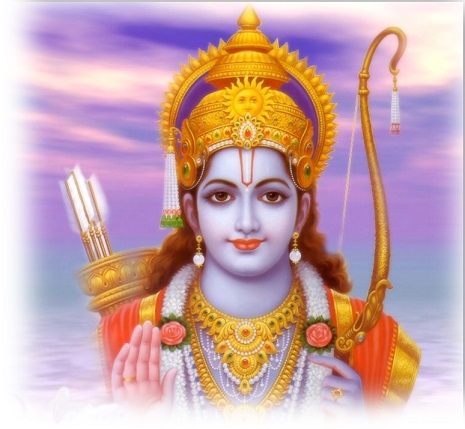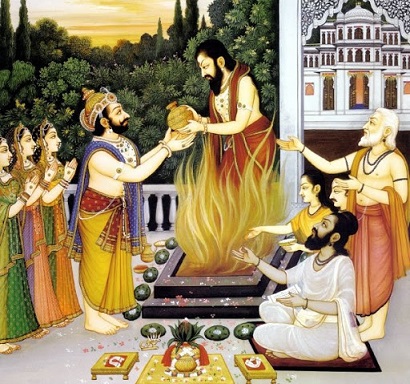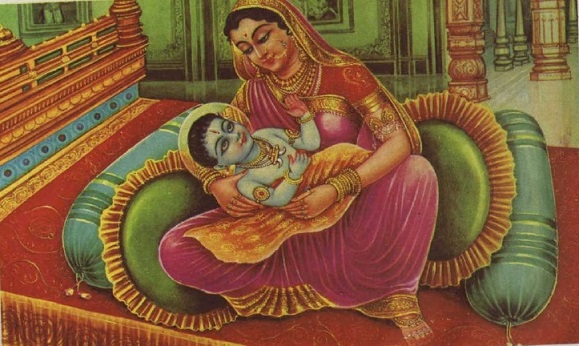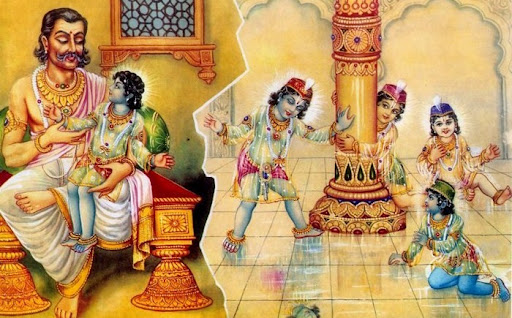Every incarnation leaves behind a set of lessons for humanity to follow. If we apply them, our lives become perfect.

Extraordinary people do extraordinary things in extraordinary ways. But some of them are even born in extraordinary ways and teach extraordinary lessons by the way they are born and by the way they live. One such an extraordinary incident is the birth of Lord Rama . Let us enter into the scene in Ayodhya at the pre-birth of Lord Rama . Dasaratha , the mighty king of Ayodhya , seemed to be a complete man. He had everything a man could aspire for and probably more. Yet, he was dissatisfied. The presence of everything in his life was overshadowed by the absence of a son. Just as a small coin that can cover the eye to block out the brightness of the majestic sun, the absence of a son eclipsed the grandeur of Dasaratha's limitless fortune and blessings. He thought an asvamedha – yajna (a horse sacrifice) would award him a son. Under the able guidance of Risyasringa and Vasistha , the sacrifice was carried out.
With the end of the sacrifice, an effulgent personality clad in black and red robes emerged. The tall-as-a-mountain red-faced personality with facial hair as soft as the mane of a lion wore the most opulent of ornaments. His powerful arms held a golden vessel with a silver lid. The vessel dazzled and appeared to be illusionary. He handed over to Dasaratha the golden pot, receiving which was the peak of the sacrifice. After instructing Dasaratha to divide the nectarine sweet rice in the vessel among his principal queens, he disappeared into the sacrificial fire.
The vessel of divine dessert gave him a new lease of life and new hope. The exuberant Dasaratha ran to his queens. Among the many queens he had, Dasaratha chose the three queens qualified enough to receive the divine rice dessert.
The Valmiki Ramayana explains how Dasaratha divided the nectarine rice dessert among his queens. He first divided it into two portions, giving half of it to Kausalya , his first wife. Kausalya also known as Hrilekha was the one who possessed and spread divine virtues. She had her share of the dessert as soon as she received it, wishing for a son who would eventually become the king of the world.
Dasaratha halved the remaining dessert yet again. This time he gave one half to Sumitra , his second wife. Sumitra was also known as Hrilekha , one endowed with opulence and who shared this quality with those connected to her. Sumitra held her share in her hands in a prayerful mood and did not consume the dessert.
Dasaratha further divided the remaining half into two portions, half of which he gave Kaikeyi , his third wife. Kaikeyi was Kértilekhä, one endowed with glory and fame and she, too, shared this quality with those around her. As soon as the dessert fell into her outstretched hands, she consumed it with the eagerness of the nestling feeding off its mother’s beak, praying that her son becomes glorious.
The order in which the queens had the divine dessert indicated their mood and the mood of their children. Kausalya received and had the dessert first, clearly indicating that her son would be the supreme Lord and the heir to the throne of Ayodhya . Kaikeyi followed Kausalya , eagerly having the dessert, which indicated that her child would be a follower of Kausalya's son.
The last portion of the divine dessert was still left in the pot. After deep consideration, Dasaratha gave this last bit to Sumitra who still held her first portion in her hand.
Having received two portions of the divine rice dessert, Sumitra was filled with gratitude. She then consumed the divine dessert, praying for children who would be instruments of service to the Supreme Lord who was to be born. Her children epitomized service and cooperation. The twins set aside their personal desires and focused on serving their brothers.
Sumitra did not consume her share, rather she waited until Kausalya and Kaikeyi had theirs, thus indicating that she would have two sons who would be the followers of Kausalya's and Kaikeyi's sons. Sumitra exhibited the quality of non-envy while consuming the divine dessert, qualities that were reflected in her sons.

As soon as the three queens ate their share of the divine dessert, their hearts filled with the kind of joy they had never experienced before. Each could feel a divine presence in their wombs. They became radiant with the divine mercy of the Lord, and their beauty increased infinitely. The three queens bore the divine children in their wombs for 12 months.
The proof of the presence of God in one’s heart and the proof of advancement in spiritual life is that the person is filled with delight within. Such a person becomes beautiful with good qualities. Thus, the result of the presence of God is transformation of character.
Toward the end of twelve months, on the noon of Navami (ninth day in the bright fortnight or waxing moon) in the month of Chaitra (April–May), under the star Punarvasu, when all the auspicious planets were in constellation, Kausalya gave birth to the first son.
Birth in the month of Caitra (beginning of the spring season and the first month of the Vedic calendar) hinted that this child would be eternally fresh; the Punarvasu star is presided over by Aditi, the mother of demigods. Diti means the one who divides. Aditi means the opposite, one who views everyone and everything with equal vision. This child would go on to become supremely transparent in His actions, the most important quality for a leader.
The infant’s charm was beyond what words could express. His face was like the full moon, radiating effulgence that could put the moon to shame. He had smooth round cheeks and eyes like red-tinged lotus petals, His skin shone like green emeralds, soft black hair covered His head and His entire body was delicate, almost fragile, as if made up of the softest butter.
Sumitra and Kaikeyi rushed to see the child. When they held the child in their hands, they could not stop marveling at His beauty. Just then, both felt sudden movement in their own wombs. The two startled queens exchanged glances – they felt the children in their wombs trying to reach out to the child they were holding. They could understand from the outstretched skin on their stomachs that the delicate hands of their babies pressed against their womb were trying to reach out to grab the feet of the newborn. The two queens smiled, realizing that this newborn was going to unite the family.
At long last Dasaratha saw the child! What he saw left him spellbound. The beauty of the child mesmerized him, throwing him into a trance. All he could do was gaze at the child, hypnotized and transfixed, as the world around him melted away. When he held his son, he felt as if the entire universe was in his hands in its most charming form.
As Dasaratha was immersed in the splendor of his first son, Kaikeyi was taken to the maternity room. Early next morning, she gave birth to a beautiful son. It was dasami (the tenth day in the bright fortnight or waxing moon) in the month of Caitra (April–May), under the Pushyami star. The same day at noon, Sumitra gave birth to twins under the star Ashlesha , whose presiding deity was the serpent. The children were born in the same order their mothers had consumed the dessert.
Vedic names are given according to the qualities of the personality. If studied carefully, these four sons exhibited qualities perfectly befitting their names. In fact, their qualities were similar to the mood of their mothers when consuming the celestial dessert.
Born from Kausalya , Vasistha spontaneously named the first born Rama , which means the one who gives pleasure. It appeared as if the child desired that name. Never before was Vasistha so overwhelmed when naming a child, it seemed as if he did not choose the name but the name chose itself.
The word Rama can give unlimited pleasure to the hearts of the listener and the speaker. This is remarkably contrary to the word Ravana , which strikes terror in the minds of those who hear that name. While eating the dessert, Kausalya had desired a perfect boy who would give pleasure to everyone and be an ideal leader; Rama was just that! Rama gave much pleasure to His father, mother, step-mothers and all the citizens of Ayodhya . It was not merely pleasure related to His exquisite beauty but it was also that of His pleasing personality. Rama personally knew every citizen. He participated in their joys and sorrows. He was often found crying in the house of those going through a sad phase and was found celebrating in the house of those happy. His is a life of giving joy to others.

Lord Räma’s beauty was unparalleled and gave unlimited joy to His parents
Vasistha named Kaikeyi's child Bharata, which means the one with a big load on his head. It eventually came true as Bharata had to bear the burden of the kingdom when Rama left for the forest. The name Bharata meant that this boy had an infinite capacity to selflessly carry the heavy burden of responsibilities on his head.
Bharata was just like what Kaikeyi had in mind at the time of eating the dessert. He was Rama's follower, adhering to his elder brother’s instructions to the last letter. When Rama was exiled, Bharata had to rule the kingdom for 14 years. The servitude with which he ruled makes his name apt. For most people ruling a kingdom would be a pleasure, but for Bharata ruling the kingdom for 14 years was like a huge burden on his head. And he carried that burden of love to please his brother.
Sumitra's twins were named Laksmana and Satrughna . Laksmana comes from the word Lakshmi, which means wealth.
What wealth is this referring to?
The real meaning of Laksmana is one who is rich with the wealth of service to Rama . Laksmana cultivated the attitude of service to his brother Rama . He became inseparable from Rama , and always looked for opportunities to serve Him. His very life is symbolic of his name. He was eager to collect this wealth of opportunities of service.
Satrughna means one who conquers his enemies.
Satrughna barely fought any battles — He is known to have killed only one demon, Lavanasura . Then why was He known by this name? Satrughna lived a life of servitude to Bharata. He resisted the temptation of serving Rama and focused on serving Bharata. He conquered this enemy. Everyone wants to have a direct connection with God, but here is a person who wanted to serve the devotee of God. Desire is the most powerful foe. Satrughna had no desire of his own; he was happy to dedicate himself to the desires of Bharata.
Laksmana and Satrughna were just what Sumitra had thought at the time of eating the divine dessert. The two children imbibed the mood of their mother, the desire to assist and serve in a spirit of cooperation. Laksmana served Rama all his life, and Satrughna served Bharata all his life. Assisting the great is a far superior act of greatness than being great, because assisting requires the remarkable quality of humility.

The four brothers grew up in Ayodhya and exhibited great
love and affection for each other
The four brothers’ names signified many things at many levels. At the devotional level, Rama led by example that whatever the situation, one should always follow the principles of truthfulness and instructions of wise superiors. Laksmana ’s exemplified that the purpose of one’s life must be to serve the Supreme Lord in totality, with the mind, words and actions. Bharata showed the world that one should follow the Lord’s commands without questioning. And Satrughna exemplified that serving the Lord was important, but it was just as important to serve His devotees.
The Sri Vaisnava acaryas explain how these four brothers represented many things at different levels. At the societal level, the four brothers represented the four basic aims of human life – dharma, artha, kama and moksha , which are righteousness, duty and morality, wealth and prosperity, worldly desires and liberation. Rama represented dharma, Laksmana represented artha, Satrughna represented kama and Bharata moksha .
Dharma and moksha represent the spiritual aspects of life, while artha and kama represent the material aspects. Most people focus on artha and kama , conveniently neglecting and not even feeling the need for dharma and moksha . The Ramayana suggests that artha be kept close to dharma and kama close to moksha , only then life can be fulfilling. If artha and kama are kept as the exclusive goals of life, they will ruin a person. In short, artha and kama have to be restrained within the boundary of dharma and moksha . Dharma refers to supreme religiosity and righteousness, which involves developing our love for God. Artha refers to wealth of service and kama to intense desire to serve God’s devotees. moksha refers to liberation or freedom from the burden of worldly attachments.
That Laksmana always accompanied Rama indicated that artha or economic pursuit were to be guided by dharma or higher wisdom. Satrughna always accompanying Bharata indicated that kama or desires ought to be directed toward moksha or perfection.
One has to dovetail all desires and give wings to only those that help one achieve the higher purpose of loving God. A good human being balances material aspirations and spiritual goals. Both these life goals should complement each other. A balanced human being is physically, mentally, intellectually and spiritually developed.
At the fundamental level, Rama was the Supreme Lord Himself who descended on earth. Bharata was the Sudarsana Cakra, or the wheel of the Lord. Laksmana was the snake bed or Ananta Sesa of the Lord, and Satrughna the Pancajanya Sankha, or the conch, of the Lord. Rama was thought to be an incarnation of Vasudeva, Laksmana of Sankarsana, Bharata of Pradyumna and Satrughna of Anirudha, all of who were primary reincarnations of Vishnu in the spiritual world.
Subha Vilasa Dasa is a resident monk at ISKCON Mumbai. He is the author of Ramayana — The Game of Life, a six-volume series that distills lessons from the epic for practical life application. This article has been adapted from this book. Contact him at shubhavilas@gmail.com. Visit: www.tulsibooks.com
